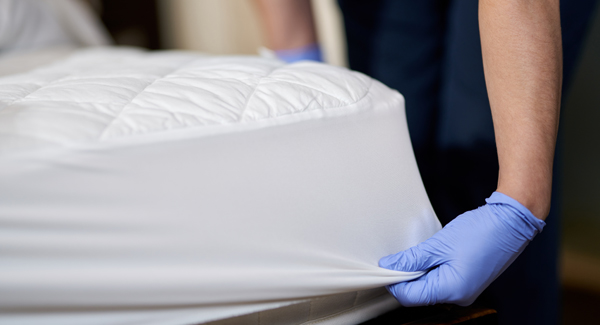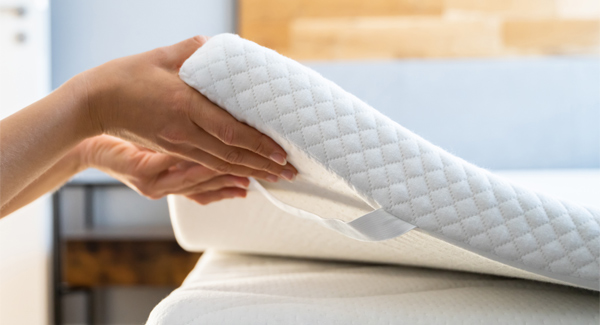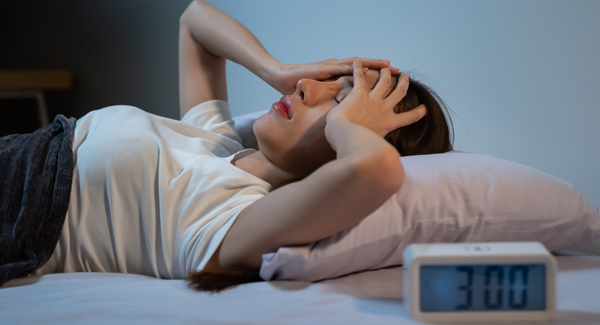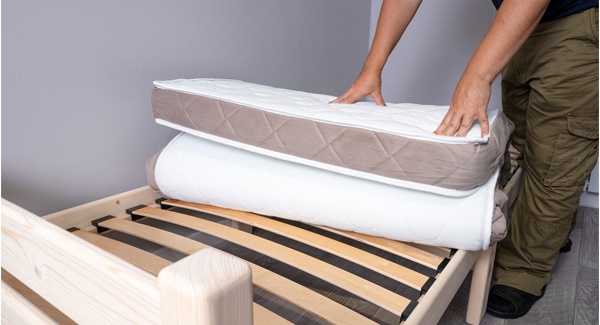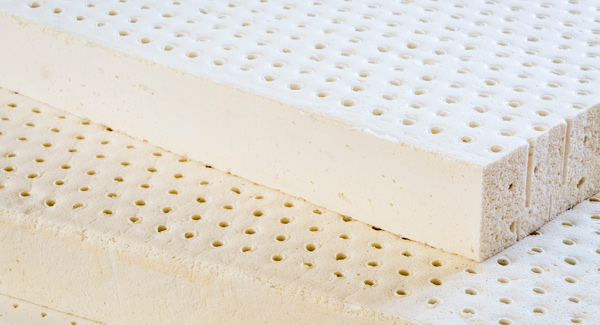Home » Bedding advice » Protection Matters: What Is A Mattress Protector?
What is a mattress protector?
Article navigation
- Published:
- Written by: Tony Brown
- Topic: Bedding advice
A mattress protector is a removable cover that helps keep your mattress clean, hygienic, and in good condition.
It fits on top of your mattress and is typically held in place with elasticated corner straps or an elasticated skirt that stretch over the corners of the mattress. Encased models are also available that cover the entire mattress.
As mattress protectors are sold separately, some people choose not to use one, exposing their mattress. Each night, your bed absorbs moisture, dead skin cells, bodily oils, and even food and drink. An unprotected mattress can quickly become a breeding ground for bacteria and dust mites, triggering allergies. The mattress can easily get soiled, making it difficult to clean, and liquids may seep through the mattress damaging its components.
Don’t confuse a mattress protector with a mattress topper; they are entirely different. A topper is designed to improve comfort by making a mattress feel softer or firmer.
What are the benefits of using a mattress protector?
There are several reasons to use a mattress protector.
Protection from stains, spillages, and seepages
Even if you’re a careful person, accidents in bed can and do invariably happen. This might be anything from a spilt drink to wetting the bed.
A mattress protector creates an extra barrier protecting the mattress from stains, spillages, and even bed bugs. It can also create a clean, healthy sleeping environment free from allergens and dust mites.
A mattress protector helps to reduce allergies
Allergies can make sleeping an uncomfortable experience, and as we spend most of our time in the bedroom, it’s vital to keep allergy triggers under control. A mattress protector can create an effective barrier against dust mites, a common cause and trigger of asthma and allergic reactions.
Easy to clean
Most mattress protectors are machine washable for easy cleaning. Care instructions vary depending on the type of mattress you choose. And since the covers are easy to remove, you can keep the sleeping surface fresh, clean, and free from allergens.
In general, you should wash the mattress protector before using it for the first time as this will help soften the product making it more flexible. It will also eliminate any odours from the packaging.
Having two mattress protectors is a good idea, so you always have a spare to hand when the other is in the wash.
A mattress protector can extend the lifespan of your mattress
Our beds withstand all kinds of spillages throughout their lifetime. Using a protector can prolong the life of the bed by preventing liquids from penetrating the mattress, which would otherwise stain the mattress or damage its components.
Cost-effective
Replacing your bed can be an expensive task. An unprotected bed will likely need replacing sooner than expected. A protector is a cost-effective way to keep your mattress clean and in good condition so that you don’t have to replace it as often.
Using a protector can help to preserve the mattress guarantee or warranty
Most manufacturers recommend the use of a protector with a new mattress. Some may include a clause in their terms of use which may invalidate the guarantee or warranty if the mattress is soiled. So not only does a mattress cover protect against stains, spillages, and accidents, but it can also preserve the guarantee.
What are mattress protectors made from?
Mattress protectors can be made with various materials that will affect their performance. Cheaper protectors are often made from synthetic materials like polyester. In contrast, higher-quality protectors tend to be made from natural materials, such as wool which are breathable and more resilient.
Polyester
Polyester is a synthetic material that retains its shape and appearance. It is easy to wash and dries quickly. Polyester is durable, wrinkle resistant and also tends to be cheaper than other materials. However, polyester is not breathable, and as it retains heat, it may make you feel warmer in bed.
Polyurethane
Waterproof mattress protectors often come with a polyurethane backing preventing liquids from reaching the mattress. Typically polyurethane is breathable, so it doesn’t make you feel hot in bed. It is also soft and quiet in use.
Some mattress protectors use PVC or vinyl for waterproofing, but these materials tend to retain heat making them uncomfortable to sleep on.
Wool
Wool is naturally soft and supportive, making it an ideal component for bedding. It is moisture absorbent and fully breathable, which helps to keep you comfortable throughout the night. Wool is also hypoallergenic, making it a good choice for those that suffer from allergies and breathing conditions. The material is exceptionally resilient and durable.
Cotton
Cotton is a popular material as it is soft, hypoallergenic and gentle on the skin. It is moisture absorbent and breathable, helping you feel cooler and comfortable in bed.
Bamboo
Sometimes referred to as ‘the green steel’, bamboo is renowned for its strength and durability. Bamboo fabric is soft, breathable and temperature-regulating. As bamboo is fast growing, it is also highly sustainable and good for the environment.
Tencel
Tencel is made from sustainably sourced wood pulp through eco-friendly practices. It is highly absorbent and naturally breathable. Its moisture-wicking qualities draw sweat away from the body, keeping you cool and dry throughout the night. Tencel is soft and gentle on the skin, making it a popular choice for bedding.
Types of mattress protector
How the mattress protector is attached to the bed depends on its design. Each design offers different levels of protection.
Most mattress protectors attach to the bed like a fitted sheet with an elasticated skirt that stretches over the corners of the mattress. Since the protector is elasticated, it should fit snugly over most mattresses covering the top and sides.
Basic models tend to come with elasticated corner straps to hold them in place. It can provide a tighter fit but only partially covers the mattress by protecting the sleeping surface but leaving the sides and bottom exposed.
An encasement-style protector covers the entire mattress, including the underside. Encasements are typically zippered, preventing liquids, mould, mildew, pet dander, dust mites, and moisture from penetrating any part of the mattress.
What to consider when choosing a mattress protector
We should all invest in a good quality mattress protector to promote a clean, safe, and comfortable sleeping environment. But with so many options to choose from, it can be difficult to know where to start. Here are some things to consider.
Fit
A mattress protector should fit snugly around your mattress. However, some mattress protectors do not account for mattress depth. If the protector is too tight, the extra pressure could damage the mattress. If the protector is too baggy, it could slip off during the night, exposing the mattress. Make sure to measure your mattress before you buy a protector to ensure the two are compatible.
Compatibility
It helps to ensure that the mattress and protector are suitable for use together. For instance, using a thicker mattress protector with a memory foam mattress adds an extra layer between you and the material, reducing its ability to conform to the body. A thinner mattress protector may be a more suitable option for memory foam, as it protects the mattress without impeding comfort or performance.
Breathability
Breathable materials such as wool and cotton absorb moisture and allow good air circulation, helping to regulate your body temperature in bed. Some mattress protectors might make you feel hot in bed because they are made with non-breathable materials. Synthetic materials, for example, are not as absorbent or breathable and tend to retain heat.
Noise
Most of us need a quiet bedroom environment to get a good night’s sleep. Depending on the material, some mattress protectors may make a rustling sound when in use. Unwanted noises can interrupt sleep, leaving us feeling tired and groggy when we wake up. To combat this, you may want to consider a mattress protector that is rustle-free and quiet in use.
Waterproofing
Waterproof mattress protectors often feature a backing material or membrane that prevents the mattress from getting wet. Waterproof protectors are ideal for younger children or adults affected by incontinence.
However, some waterproof protectors are not breathable and may rustle and make unwanted noises when you move around in bed.
Final thoughts
You should consider a mattress protector as an essential part of your bedding. Keep in mind that mattress care goes beyond just protecting the sleeping surface. It is also important to turn your mattress where necessary and follow the manufacturer’s care advice.
Share this article

About the author
Tony Brown is the founder and creator of The Bed Consultant. His career in the bed industry began in 2002. After graduating from university with a degree in Business Administration, Tony joined one of the largest independent furniture retailers in the UK as a bed consultant. Tony has helped thousands of customers find the perfect mattress.

